
With much talk about dimethyl ether (DME) and renewable dimethyl ether (rDME) and the potential for creating propane blends with lower carbon intensity (CI), it’s imperative for the propane industry to keep a close eye on both the benefits and challenges they present. BPN sat down for a conversation with Jim Bunsey, director of commercial business development for the Propane Education & Research Council (PERC), to talk all things DME/rDME, propane blends and renewable propane.
BPN: Can you give a basic explanation of DME/rDME?
Bunsey: DME and rDME are basically the same compound as propane, except they have one oxygen molecule. It bonds well with conventional propane. They have a very low CI. They can have a CI of close to negative 273. What we’re trying to do in the industry is bring DME in and make it a blend so we can still have conventional propane with near zero or even negative CI scores.
What infrastructure challenges arise in using a propane/DME blend?
Propane has infrastructure all across the U.S. We have barge terminals, truck terminals, pipelines — but there’s not a DME system set up. We do have some compatibility issues that we’re working through. We’re seeing right now, if we can go with a 5% blend, 10% blend, or up to a 25% blend, we don’t have to change any propane infrastructure. But that oxygen molecule makes some changes. It actually helps it burn cleaner in some cases, but the oxygen brings in the chance for corrosion.
When propane is stored in our tanks, there’s no corrosion inside of the tanks, and the seals, pumps and valves are designed for liquid petroleum gases. We can have blends of butane, propane and propylene. But we’re not really listed with DME. Because it has an oxygen molecule, things do change. And that’s why as an industry, we’re working with them because if we can go 5% DME with a negative 273, and we have a conventional propane of 79, then we start getting CIs down in the 20s and 30s. And that keeps states like California talking to us.
Is staying below a certain percentage how you avoid the corrosion and some of these challenges?
That’s what our studies say, and that’s what we’re seeing. Most of the studies right now are for on-road equipment or internal combustion engines, and we’re having good results. The next step is when we start to look at the domestic market [and] vapor service. In all the homes, we have vapor service rather than liquid service. When it stays in liquid, it stays mixed together. But when we use vapor, then you start to have separation. Maybe more propane comes off, maybe more DME comes off, and we don’t know where the blends change in the tanks. That’s where the studies are and where the money’s being spent right now to come up with rules and regulations of how the blends can go out, how much you can have in. … There is a mix and there is a percentage of the mix. Once there’s a study of the facts, figures and science behind it, they’re going to say, ‘OK, 8% DME is fine. It can go in all of it, and it doesn’t affect anything.’ Until we get there, we need the science behind it to make the true decision of how to do it. And it’s going to happen, we just need to be ready to do it properly.
How difficult would it be for the industry to have to rework all this infrastructure equipment?
We’re trying to use the existing infrastructure without making changes. We represent 3,200 marketers across the U.S. — that’s the propane industry. … We don’t want to disrupt it, so that’s why we’re doing this. There are all these new blends coming. There isn’t [a single] solution. It’s going to take multiple solutions for the energy that’s going to be required to get us to 2036. That’s why we want the industry to keep an open mind. … We’re going to do studies — and it’s happening fast, but we’re going to do it properly so we can have these blends available to everybody to help become carbon neutral and be good stewards to the earth. That’s our end result.
How does renewable propane factor into this?
There are a lot of new processes coming out to make renewable propane, which is great because … we’ve always been the byproduct of processing natural gas and other fuels. So as the renewable feedstocks come in, we’re letting the processors know there’s value to that renewable propane because they take it and put it back in the process for making their fuels because it takes heat and energy. [Renewable propane] actually changes their CI score.
Do you think the challenges we discussed previously will affect the future of renewable propane?
No. But it’s going to be part of it. Even if it’s a 5% blend that goes in, and as regulations change and allow it, we don’t want people to have to change their equipment. Propane-powered equipment is going to be ready for the blends coming down the road, and that’s how we’re going to regulate it and bring it in because we don’t want to need different pumps, seals and fittings. Even that one oxygen molecule doesn’t completely change it, but there are some infrastructure solutions we want to make sure it changes. One-hundred percent DME has different seals and elastomers than 100% propane. That’s where we want to watch the blends. We’re pushing it so the DME blends are going to be able to be dropped into conventional propane. The shift right now is because the renewable propane sources have become available, and it’s an easier transition because we don’t have compatibility issues. But I’m not counting it down because we’re going to need it all to make sure we stay successful in this game.


